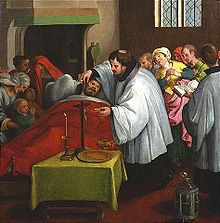Accessories

A Versehgarnitur (also: Versehbesteck ) there was until the middle of the 20th century in many Catholic households. The priest used them in administering the anointing of the sick .
history
From the 16th century onwards, wealthier people had booth crosses next to their bed, which were also used to administer the sacraments. From the middle of the 19th century, even simpler believers began to purchase such crosses, which were later expanded to include a decorated tray. By the beginning of the 20th century at the latest, a pair of cutlery was one of the typical wedding gifts or a dowry gift .
composition
A provision set usually includes a stand cross, a smaller death cross , a larger silver tray and three smaller silver bowls , often also another glass bowl for holy water, and a small white cloth with which the priest could dry his fingers.
use
Often times, when the priest visited a sick person about an accident, the family would have the accidental set ready by the bed. The death cross was given to the sick person to be kissed before confession. In one of the bowls there was a little salt for cleaning the priest's hands after the anointing with the sick oil , in a second water for the ablution of the fingers after the giving of communion . After the ablation, the priest drank the water with the host particles.
